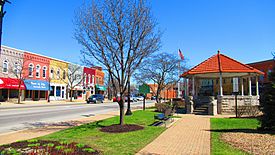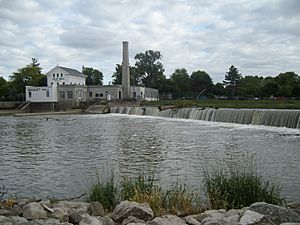Dundee Historic District facts for kids
Quick facts for kids |
|
|
Dundee Historic District
|
|

The historic district along M-50
|
|
| Location | Dundee, Michigan |
|---|---|
| NRHP reference No. | 90001239 |
| Added to NRHP | August 20, 1990 |
The Dundee Historic Village is a special area in Dundee, Michigan, where many old and important buildings are protected. It's like a time capsule showing how the town grew. This district was officially recognized as a historic place on August 20, 1990.
People often call this area downtown Dundee. It started around the same time as another historic area in nearby Monroe. Both towns grew up next to the River Raisin, which was important for travel and trade. At first, the buildings here were small and made of wood. Over time, these were replaced with bigger, two-story buildings made of brick. Most of the buildings you see today were built between 1866 and 1900. However, the history of this area goes all the way back to when Dundee was founded in 1825.
Contents
Where is the Historic Village?
The Dundee Historic Village is located about one mile east of US-23. You can find it along M-50, which is known as West Monroe Street or Tecumseh Street. The district is right where the River Raisin makes a bend.
Most of the historic area is on the north side of the river. This includes streets like Riley, Ypsilanti, East Main, and Tecumseh Streets. A smaller part of the district is south of the river, on West Monroe and Toledo Streets.
The "Triangle District"
Locals sometimes call this area the "Triangle District." This is because of the unique shape where Riley and Tecumseh streets meet. They cross at a 45-degree angle, creating a triangular piece of land. This triangle is cut off by Park Place on the west side.
The original owners of this land gave it to the village. They asked that it always remain an open park for the community. Today, this special triangle is known as Memorial Park. It has a naval cannon and a bandstand, which is a covered outdoor stage.
The Old Mill Museum
One of the most famous buildings in the district is the Old Mill Museum. It's located at 242 Toledo Street, across the river from most of the other historic buildings. The museum building itself was built in the 1850s. However, the dam it sits on was first built much earlier, in 1827, and then rebuilt in 1846.
History of the Mill
- Early Use: The building first worked as a gristmill. A gristmill grinds grain into flour, which was very important for the growing town of Dundee.
- Power Plant: Around 1910, the building was changed to produce electricity. It became the village's only source of power, using the river to create hydroelectricity.
- Henry Ford's Factory: In 1934, famous car maker Henry Ford bought the building. He spent a lot of money to fix it up. Ford used it as a small factory to make welding tips for his car industry. He visited Dundee often. Ford was interested in seeing if small towns could be part of his large global business.
- Later Years: After Ford passed away in 1947, the small factory closed. In 1954, it was sold to the Wolverine Manufacturing Company. They changed the building again to make paper products. The company used the building until 1970.
- Museum Today: The village then bought the building and its surrounding 13.8 acres (5.6 ha). They turned it into a public museum and park. Even though the Old Mill Museum is very historic, it is not listed on the National Register of Historic Places by itself.




